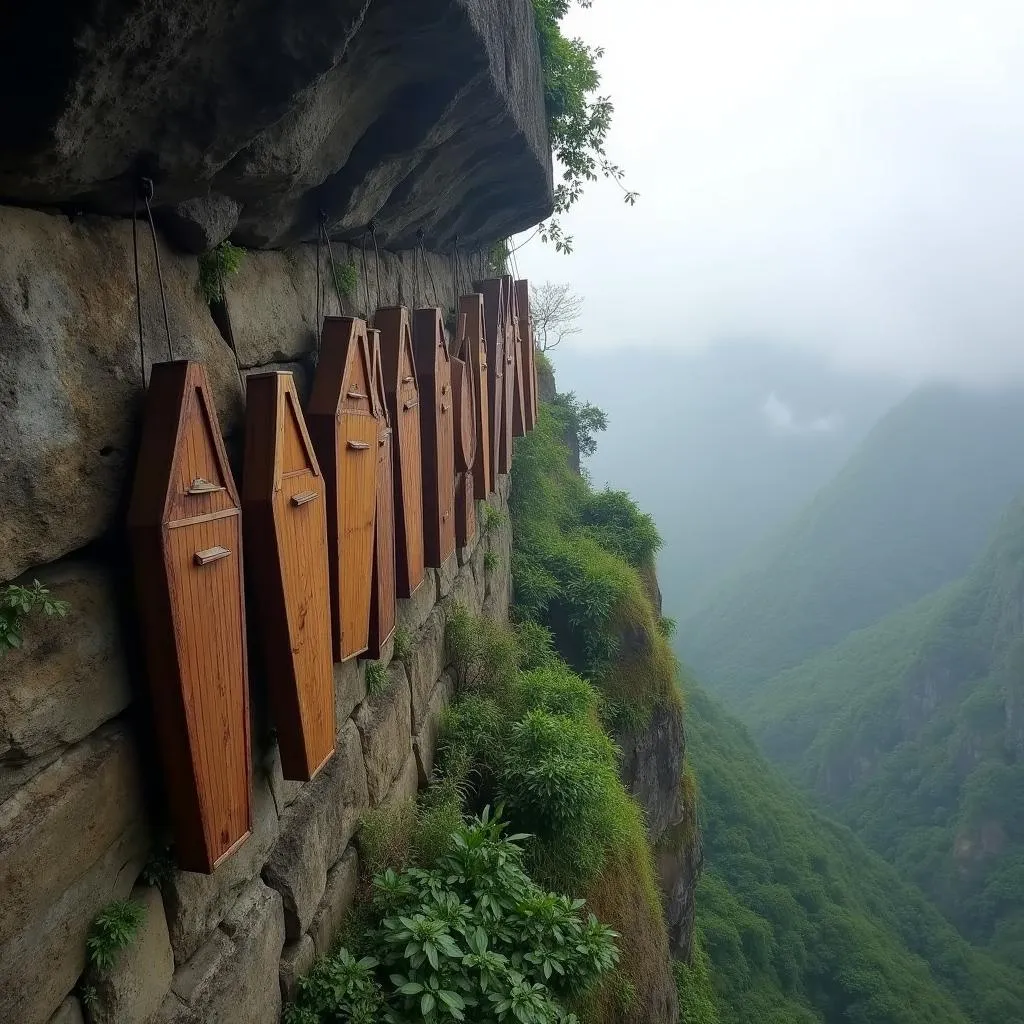The IELTS Speaking test often challenges candidates to describe various aspects of their home country, including mysterious places. This topic not only tests your language skills but also your ability to engage the examiner with intriguing details. Let’s explore how to tackle this subject effectively and boost your chances of achieving a high score.
Part 1: Introduction and Interview
In this section, the examiner may ask general questions about mysterious places or related topics. Here are some potential questions and a sample answer:
- Are you interested in mysterious places?
- Do you believe in supernatural phenomena?
- Have you ever visited a place that felt mysterious to you?
Let’s look at a sample answer for the third question:
Sample Answer (Band 7-8):
“Yes, I have. Last year, I visited an ancient temple deep in the mountains of my country. The atmosphere there was incredibly eerie, with mist swirling around the centuries-old stone structures. What made it particularly mysterious was the inexplicable cold spots we encountered inside, even though it was a warm day outside. The local legends about spirits inhabiting the temple added to its mystique. It was a fascinating experience that left me with more questions than answers.”
Part 2: Long Turn
Here’s a potential cue card related to describing a mysterious place:
Describe a place in your country that you find mysterious
You should say:
- Where it is located
- What it looks like
- Why people consider it mysterious
- And explain your personal thoughts about this place
Sample Answer (Band 6-7):
“I’d like to talk about a mysterious place in my country called the Hanging Coffins of Sagada. It’s located in the mountainous region of Luzon Island in the Philippines.
The site consists of numerous wooden coffins that are suspended on the side of steep limestone cliffs. These coffins are often placed in seemingly impossible positions, defying gravity and leaving visitors wondering how they were put there.
People consider this place mysterious for several reasons. Firstly, the practice of hanging coffins is an ancient burial tradition of the indigenous Igorot people, but the exact methods they used to place the coffins remain unknown. Secondly, some of the coffins are hundreds of years old, yet they have withstood the test of time and harsh weather conditions. Lastly, there are local legends about the coffins sometimes emitting strange sounds or glowing at night, adding to the site’s eerie atmosphere.
Personally, I find the Hanging Coffins both fascinating and slightly unsettling. While I’m amazed by the ingenuity and dedication of the ancient Igorot people, there’s something inherently spooky about seeing coffins suspended on a cliff face. It’s a place that really makes you contemplate the mysteries of death and the afterlife, as well as the rich cultural heritage of my country.”
Sample Answer (Band 8-9):
“I’d like to describe a place in my country that has long been shrouded in mystery – the Hanging Coffins of Sagada, nestled in the remote mountainous region of Luzon Island in the Philippines.
This enigmatic site is characterized by a series of wooden coffins precariously suspended along the face of towering limestone cliffs. The coffins, some of which are centuries old, appear to defy the laws of physics, clinging to the sheer rock faces in a manner that seems to challenge our understanding of what’s possible.
The mystery surrounding this location is multi-faceted. Primarily, it stems from the ancient burial practices of the indigenous Igorot people. While we know they placed their deceased in these lofty positions as a way to bring them closer to their ancestral spirits, the exact methods they employed to achieve this feat remain a subject of speculation. Furthermore, the remarkable preservation of these coffins, some dating back hundreds of years, in spite of exposure to harsh weather conditions, adds another layer of intrigue. Perhaps most captivating are the local folklore and legends that have sprung up around the site, with tales of inexplicable phenomena such as strange sounds emanating from the coffins or ethereal glows observed at night.
From my perspective, the Hanging Coffins of Sagada represent a compelling juxtaposition of the tangible and the intangible aspects of human existence. On one hand, they are a testament to the ingenuity and cultural beliefs of our ancestors, showcasing their remarkable engineering skills and deep-rooted spiritual practices. On the other hand, the site serves as a poignant reminder of the impermanence of life and the enduring nature of human rituals surrounding death. The atmosphere of mystery that envelops this place evokes a profound sense of wonder and respect for the unknown, compelling visitors to contemplate the boundaries between the physical world and the spiritual realm. It’s a place that not only captivates the imagination but also offers valuable insights into the rich tapestry of Philippine cultural heritage.”
 Hanging Coffins of Sagada, Philippines
Hanging Coffins of Sagada, Philippines
Follow-up questions:
- How do you think the ancient people managed to place the coffins in such difficult positions?
- Do you think places like this should be preserved or developed for tourism?
Sample Answer (Band 7-8):
-
“I believe the ancient Igorot people must have used a combination of advanced rope techniques and their intimate knowledge of the local terrain to place the coffins. They likely employed a system of pulleys and perhaps temporary scaffolding to maneuver the coffins into position. It would have required immense skill and teamwork, as well as a deep respect for their cultural practices, to accomplish such a feat in these treacherous conditions.”
-
“In my opinion, mysterious places like the Hanging Coffins should be preserved with utmost care while allowing for controlled tourism. It’s crucial to strike a balance between sharing cultural heritage and protecting it. Developing the site for tourism could bring economic benefits to the local community and raise awareness about indigenous cultures. However, any development should be done sustainably and respectfully, ensuring that the site’s integrity and the local people’s wishes are prioritized over commercial interests.”
Part 3: Two-way Discussion
In this section, the examiner might ask more abstract questions related to mysterious places and cultural heritage. Here are some potential questions and sample answers:
- Why do you think people are fascinated by mysterious places?
Sample Answer (Band 7-8):
“I believe people are drawn to mysterious places for several reasons. Firstly, these locations often challenge our understanding of the world and spark our curiosity. They provide a sense of wonder and excitement that’s often lacking in our daily lives. Additionally, mysterious places often have rich histories or cultural significance, allowing us to connect with our past and explore different belief systems. Lastly, I think there’s a universal human desire to unravel the unknown, and mysterious places offer an opportunity to engage with that desire in a tangible way.”
Sample Answer (Band 8-9):
“The allure of mysterious places, in my opinion, stems from a complex interplay of psychological and cultural factors. At its core, I believe this fascination is rooted in our innate curiosity and the thrill of the unknown. These enigmatic locations challenge our preconceptions about the world, offering a glimpse into realms that defy easy explanation and thus stimulating our imagination.
Moreover, mysterious places often serve as repositories of cultural heritage and historical narratives, providing a tangible link to our collective past. They allow us to transcend the boundaries of our everyday experiences and connect with the beliefs, practices, and worldviews of our ancestors or other cultures. This connection can be profoundly meaningful in our increasingly globalized and homogenized world.
Furthermore, I think the appeal of mysterious places lies in their ability to evoke a sense of wonder and awe, emotions that are increasingly rare in our information-saturated society. They offer a refreshing counterpoint to the rational, explicable nature of much of modern life, satisfying a deep-seated human need for mystery and transcendence.
Lastly, these locations often challenge us to confront the limits of our knowledge and understanding, prompting philosophical and existential reflections. In doing so, they can foster a sense of humility and openness to alternative perspectives, which I believe is invaluable in our diverse, multicultural world.”
- How can countries balance preserving mysterious places with the demand for tourism?
Sample Answer (Band 7-8):
“Balancing preservation and tourism is a challenging task that requires careful planning and management. Countries can achieve this balance by implementing strict conservation measures while also developing sustainable tourism initiatives. This might involve limiting the number of daily visitors, creating designated viewing areas that don’t disturb the site, and investing in education programs that inform tourists about the importance of preservation. Additionally, involving local communities in the management and benefits of tourism can help ensure that economic interests don’t overshadow conservation efforts.”
Describe a place in your country that is popular for its natural beauty can also be an interesting topic for IELTS Speaking, as it allows candidates to showcase their descriptive language skills while discussing their country’s geography.
Key Vocabulary and Phrases
To enhance your performance when describing mysterious places, consider using these words and phrases:
-
Enigmatic (adjective) – /ˌenɪɡˈmætɪk/ – difficult to interpret or understand; mysterious.
Example: “The enigmatic symbols carved into the ancient stones have puzzled archaeologists for decades.” -
Ethereal (adjective) – /ɪˈθɪəriəl/ – extremely delicate and light in a way that seems not to be of this world.
Example: “The mist surrounding the old castle created an ethereal atmosphere.” -
Inexplicable (adjective) – /ˌɪnɪkˈsplɪkəbl/ – unable to be explained or accounted for.
Example: “Visitors often report inexplicable sensations of cold in certain parts of the haunted house.” -
Shrouded in mystery (phrase) – surrounded by mystery; difficult to understand.
Example: “The origins of the ancient structure are shrouded in mystery, with no clear records of its construction.” -
Captivate the imagination (phrase) – to fascinate or attract strong interest.
Example: “The legends surrounding the mysterious island continue to captivate the imagination of people worldwide.”
Describe a popular tourist destination in your country is another topic that can benefit from using such descriptive vocabulary, especially when discussing places with an air of mystery.
Examiner’s Advice
To achieve a high score in the IELTS Speaking test when describing mysterious places:
- Use a wide range of vocabulary, including less common words and idiomatic expressions related to mystery and intrigue.
- Demonstrate your ability to speak at length by providing detailed descriptions and explanations.
- Use complex sentence structures and connect your ideas coherently.
- Show critical thinking by discussing different perspectives on mysterious places and their significance.
- Practice describing various mysterious places in your country to improve fluency and confidence.
Remember, the key to success is not just in knowing about mysterious places, but in your ability to articulate your thoughts clearly and engagingly. Regular practice with a variety of topics, including those like describe a place in your country known for its natural beauty, will help you develop the skills needed to excel in the IELTS Speaking test.
 IELTS Speaking Practice Session
IELTS Speaking Practice Session
By following these guidelines and incorporating rich vocabulary and complex structures, you’ll be well-prepared to discuss mysterious places and other topics in your IELTS Speaking test. Remember to stay calm, speak naturally, and let your interest in the subject shine through your responses.


